1930s Fashion
1930s fashion was the decade of elegance and glamour .The 1930s are often thought of as a rather boring decade, the bit in between the exciting, decadent 1920s Jazz age with its crazy flappers who had thrown away all their corsets, cut their hair off and dressed like boys and smoked, took opium and danced the Black Bottom; and the awful Second World War that began right at the end of the decade, where there wasn’t any money for dresses but everyone knitted their own from recycled cushion covers and at least they were all brave and went out to work and had spirit.
In contrast, women in the 1930s abandoned trouser suits, grew their hair, permed it and dyed it a dizzy blonde, wore an awful lot of silk, fur and velvet, and looked up to very ladylike film stars. Femininity had returned to the scene in 1930s fashion – although women never did climb back into those corsets.
Fashion in the 1930s
The decade began with the immediate effects of the 1929 Wall Street crash in America, which wiped out fortunes in an instant and quickly affected the entire American economy, resulting in widespread poverty. Its influence had traumatic ramifications worldwide and one repercussion was the rise of authoritarian regimes in Europe, ultimately resulting in the Second World War of 1939.
But although many people had less money than before, they were still interested in fashion. They just had to find a way to make it fit their new, lower budget. Some have said that the sobering effects of the crash forced women to “grow up”, fashion-wise from the androgynous and girlish 1920s flapper fashions and their irresponsible and fun loving connotations, adopting more ladylike and womanly clothes with nipped in waists, ruffles and bows, sophisticated hats and hair that needed far more styling than the wash and wear short bobs that came before. But it can be seen that the styles that predominated in the 1930s actually began to be seen in the late 1920s, well before the crash, and women still did wear their cloche hats, kept their bobs and crucially, their jobs that they had started to get from the First World War onwards.
It was just a case of the usual backlash in 1930s fashion where women started to look for something new and different to wear. There were other influences at play too – influences like Hollywood.
Fashion in the 1930s and Hollywood
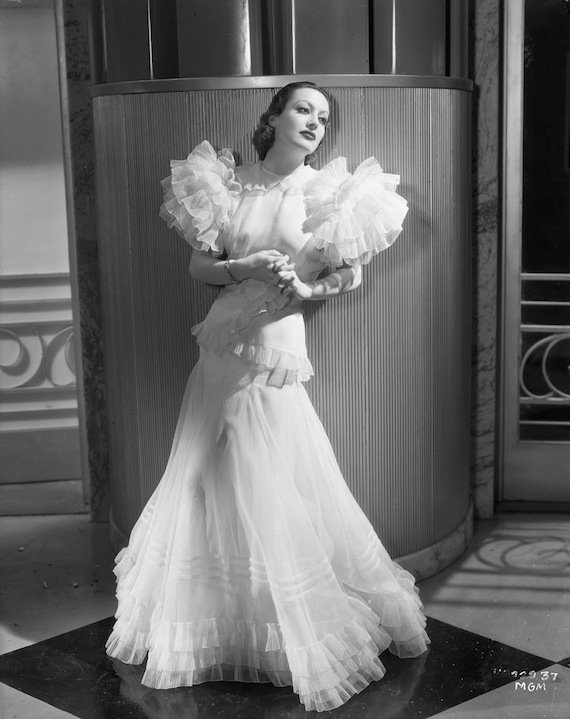
Joan Crawford in the famous dress from ‘Letty Lynton’ (1932)
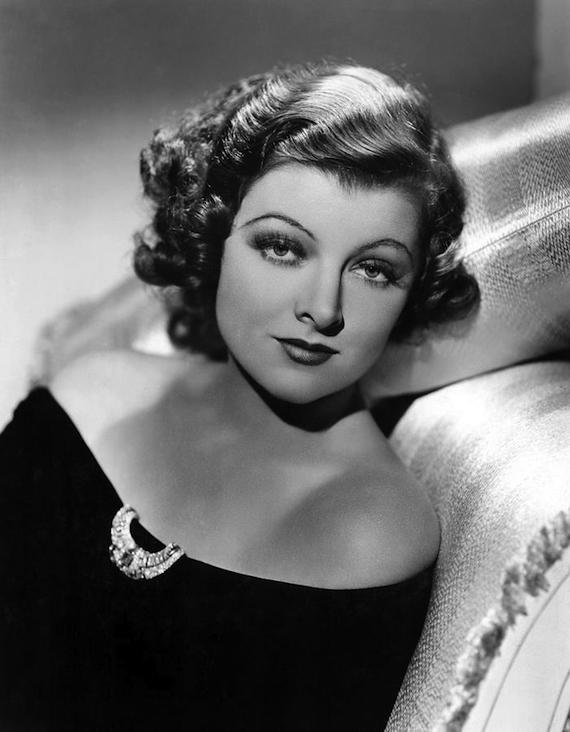
Myrna Loy, 1930s.
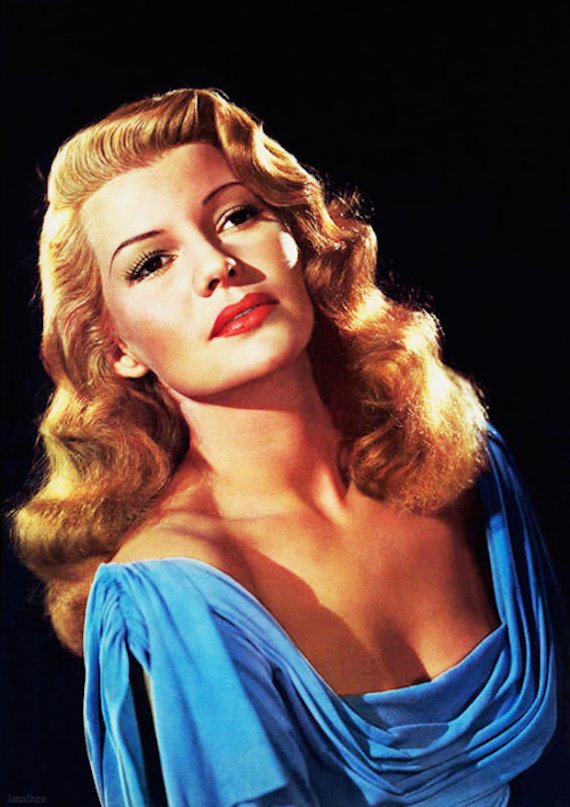
Rita Hayworth.
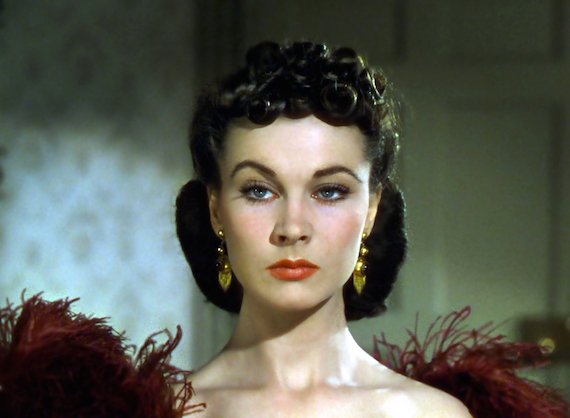
Vivien Leigh in Gone With the Wind, 1939.
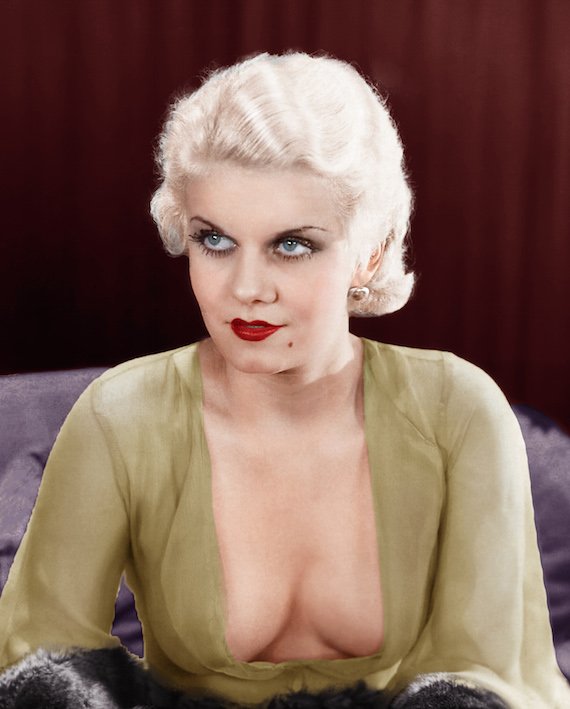
Jean Harlow.
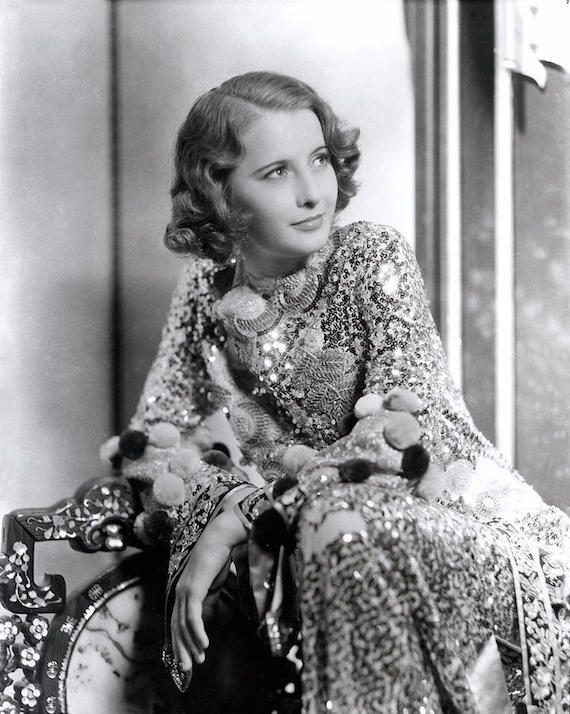
Barbara Stanwyck, late 1930s by Everett.
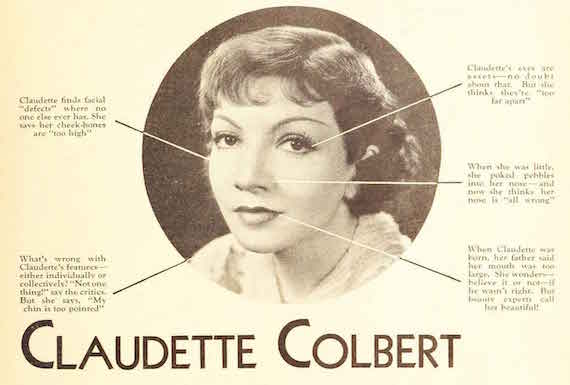
Claudette Colbert gets picked apart by the experts.
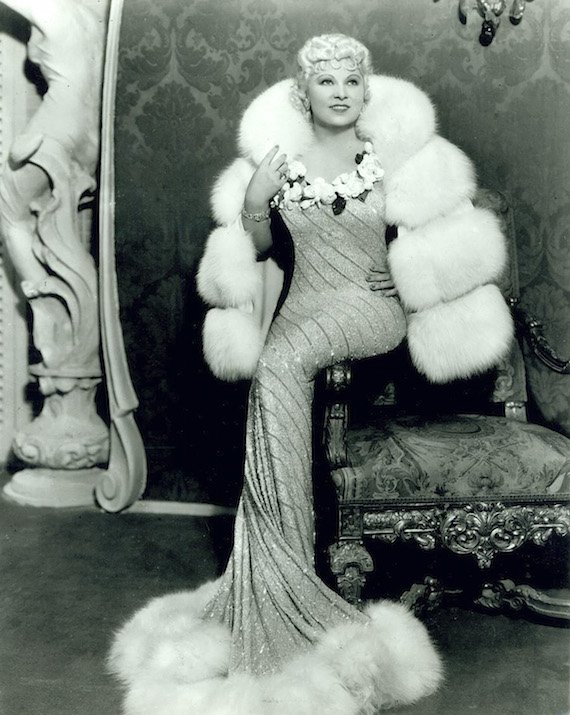
1930’s Mae West.
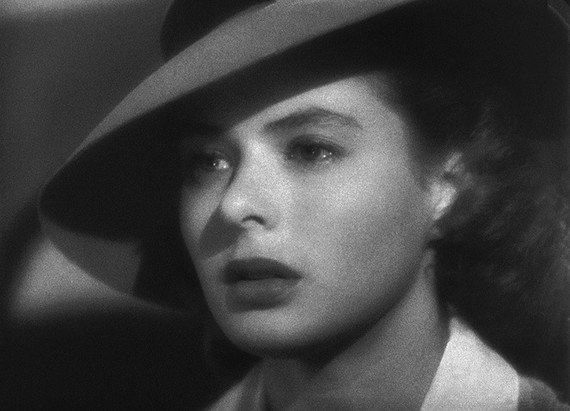
Ingrid Bergman.
The talkies had truly landed by 1930 and the addition of dialogue made for films with more nuance. Going to the cinema was an inexpensive past time in the 1930s and many people went every Saturday for their fix of the 1930s film stars, although it was looked down on by some. Film fan magazines sprang up, discussing favourite stars, the 1930s fashions they wore and regular women’s magazines didn’t shy away from the same topic. The film studios carefully moulded thier actresses into certain images, both physically with regard to the way they dressed and styled themselves as well as their bodies and faces, recommending weight control and plastic surgery where they felt necessary, but also as regards to their personalities and what they were allowed to say to the press, and who they could date and marry.
Magazine articles
Magazine articles recommended that women go to the movies and study the female stars to decide who was most like them, or most like who they wanted to be, and dress and act accordingly. This meant that an army of Vivien Leighs, Bette Davises, Katherine Hepburns and Ingrid Bergmans walked the streets and eyebrow, lipstick and hair colour and style was studied closely, along with the 1930s fashion clothing the studios normally dressed them in.
The stars also appeared in adverts for beauty products and food, and as well as that, studios were very keen on product placement within the films themselves.
Although Hollywood designers had initially dressed their stars in faithful copies of Parisian clothes, studio bosses realised that by the time the film came out, which could be up to a year later, the clothes looked outdated. So the costumiers were instructed to design their own gowns, following the general feel of fashion yet with their own spin. The costume department had a ball with this, and their creations were often far more flamboyant than anything Paris had to offer. Their over-the-top-ness didn’t stop movie goers from desiring exact copies of whatever 1930s fashions film stars wore however, and when Joan Crawford appeared in “Letty Lynton” in a floor length white cotton organdie gown with huge ruffled sleeves designed by Adrian in 1932, copies of the dress sold in their thousands.
1930s fashion and home sewing
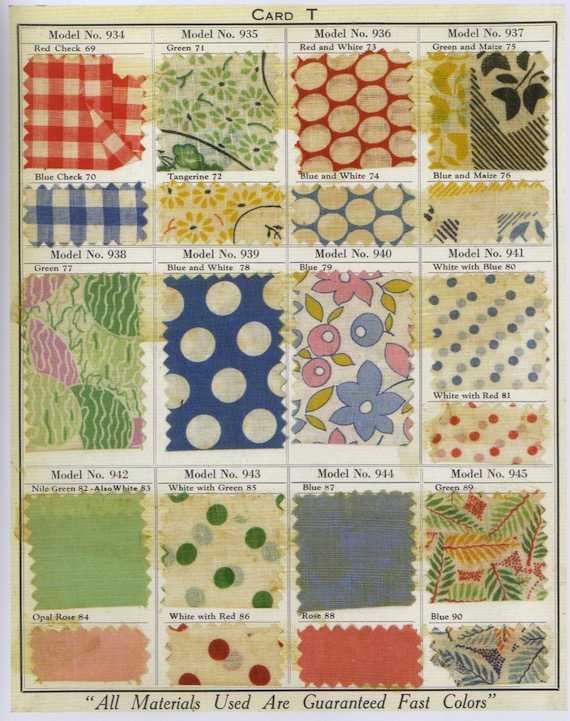
Cotton fabric samples, c.1930.
In 1930s fashion It was still usual for the vast majority of women in England and Europe to sew their own and their household’s clothes. Most working class women would have owned a sewing machine, and those middle class ones who didn’t picked out fabrics and designs they liked and took them to their dress maker.
Cheap, mass produced ready made clothes were also available, and in response to the crash demi-tailored clothes began to be offered in American department stores. Each garment was half completed with all the fiddly bits already done, and just a few seams to be sewn to make the garment fit to the individual measurements of the person they were for. The adverts stressed that these seams were extremely simple, and the whole thing could be completed by a beginner. They were aimed at the formerly rich who suddenly couldn’t afford their dressmaker, had no idea how to make clothes themselves and yet couldn’t bring themselves to contemplate mass produced clothing. It was a successful compromise.
Both in America and in the UK clothes catalogues were launched. Sears for the US and Littlewoods for the UK were useful for the new breed of working women who didn’t have time for leisurely shopping trips. The option to spread the cost was also appealing. Clothing Fashion in the 1930s offered in catalogues were up to the minute and included copies of Paris models or silver screen dresses.
1930s fashion – Parisian couture
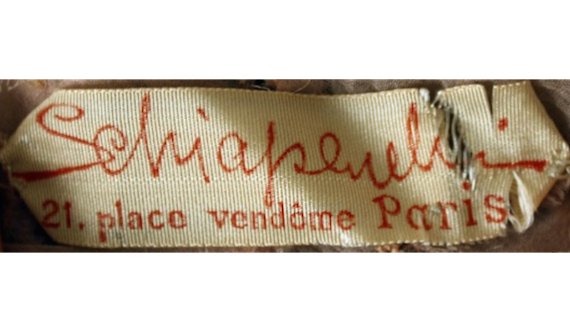
Schiaparelli label.
Parisian couture houses were hit hard by the Depression. Couture clients who had previously come to visit from all over the world dropped off, and even their trade in licensing models to be copied for ready to wear by department stores suffered, as several stores now clubbed together to buy the licence for one model when before they would have bought one each. Instead they promoted home grown designers. Huge and off putting import taxes were also levied on Parisian clothes, particularly in America where it could be as much as 90% tax. Because of this, many 1930s fashion couture clothes of the time that you may see in museums may have had their labels cut off, to get around customs.
1930s dresses
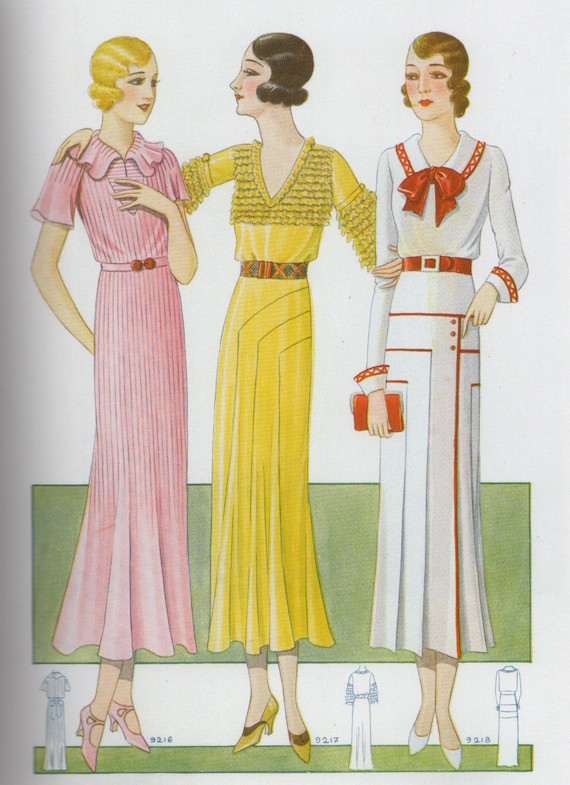
Three afternoon dresses, 1931.
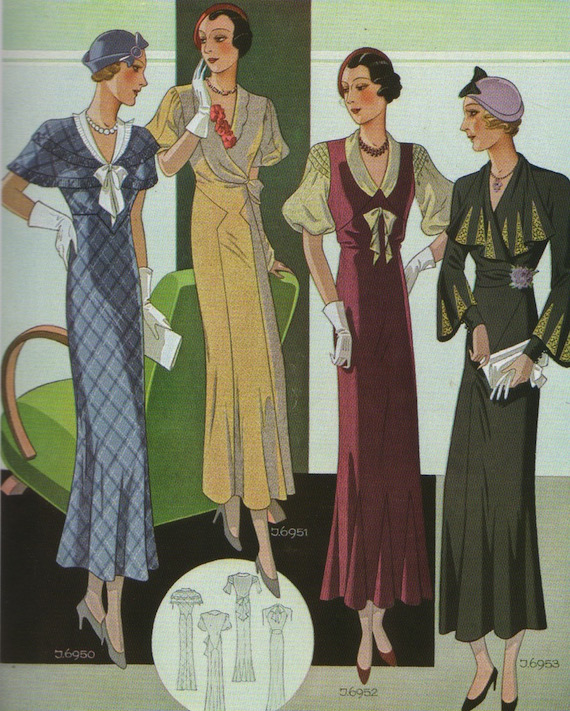
Day dresses.
Although the silhouette of the mid-1920s had been flat and simple with hemlines at just below knee length, by the end of the decade it had begun to come down and entering the 1930s daytime skirts were mid calf length. They dropped an inch or two lower before rising again to just before knee length at the end of the decade. For evening wear, skirts were floor length.
Day wear and evening wear in 1930s fashion were full of flounces and decoration. Tailoring was in and the silhouette was triangular, with shoulder pads in dresses and suit jackets alike. 1930s dresses were darted around the bust and fitted around the hips, falling to a straight skirt that often had gentle flutes through the insertion of bias cut panels or pleats. Cap, elbow length and wrist length sleeves were worn, usually with volume at the top and narrowing towards the wrist. Interesting necklines were key, with collars and cut outs, mock jabots, draping, frills, bows, buttons and fastenings to add interest. Sometimes skirts were also decorated with buttons, waterfall flounces and frills too.
1930s blouses and suits
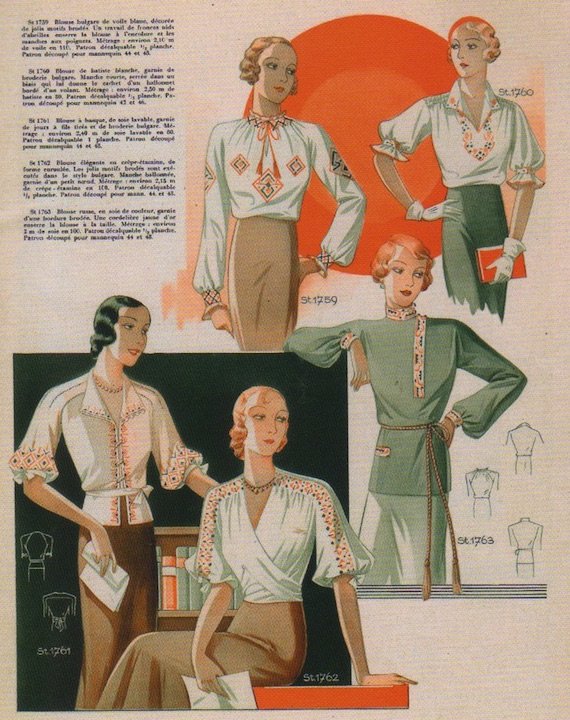
The Bulgarian style blouse, 1933.
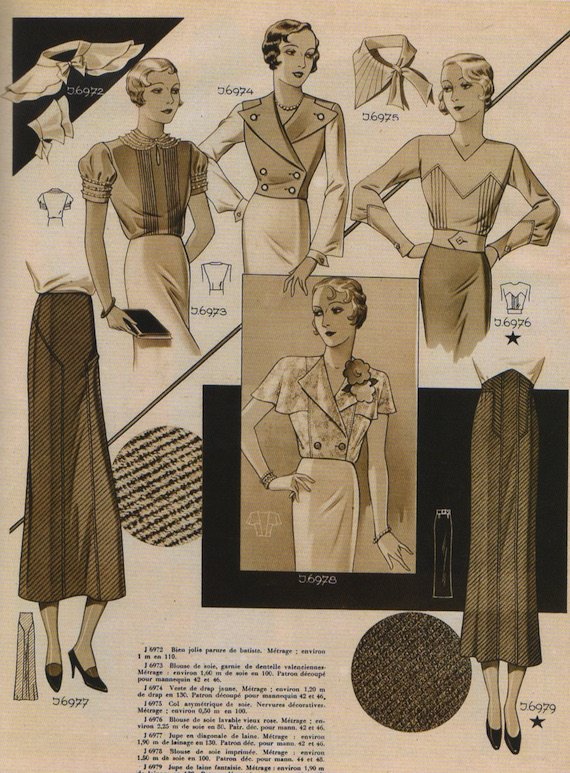
Blouse, collar and skirt combinations, 1933.
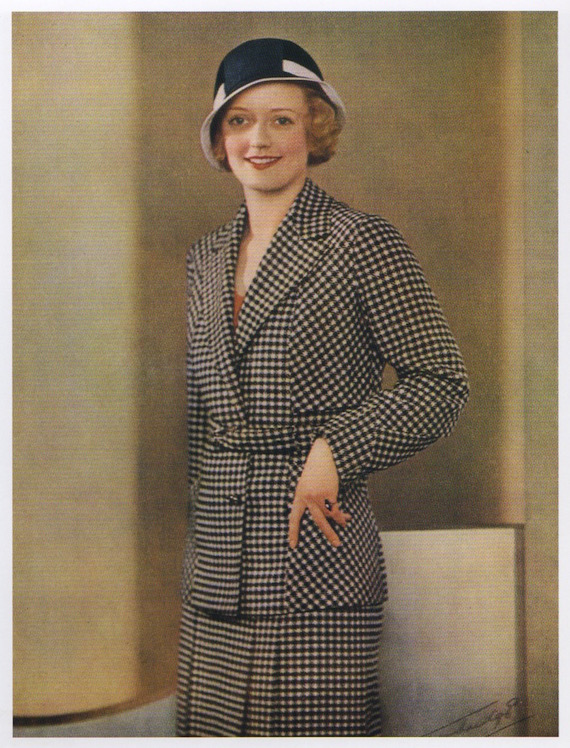
Sports suit.
In 1930s fashion there was a brief trend for embroidered “Bulgarian” blouses in white cheesecloth, but this was positively simple compared to most blouses which seemed to come in every colour but white, and were wildly decorated.
In amongst this frippery and frills were also some very plain black and white or chocolate brown structured suits, and simple, pretty cotton print dresses which could easily be washed. In America, these dresses were made from the specially-printed cotton fabric of flour, sugar and feed sacks, and were known as feed sack dresses.
A typical day ensemble might be blouse and skirt, a blouse and skirt set designed to match together, a dress (very common), dress with matching bolero or cape, or a “sports suit” which was in no way designed to play sport in but was a tailored jacket, skirt and blouse. Topping this would be a fur or wool coat, with hat, gloves, scarf, handbag and high heels, maybe a muff for very cold weather.
The colour of outfits in 30s fashion
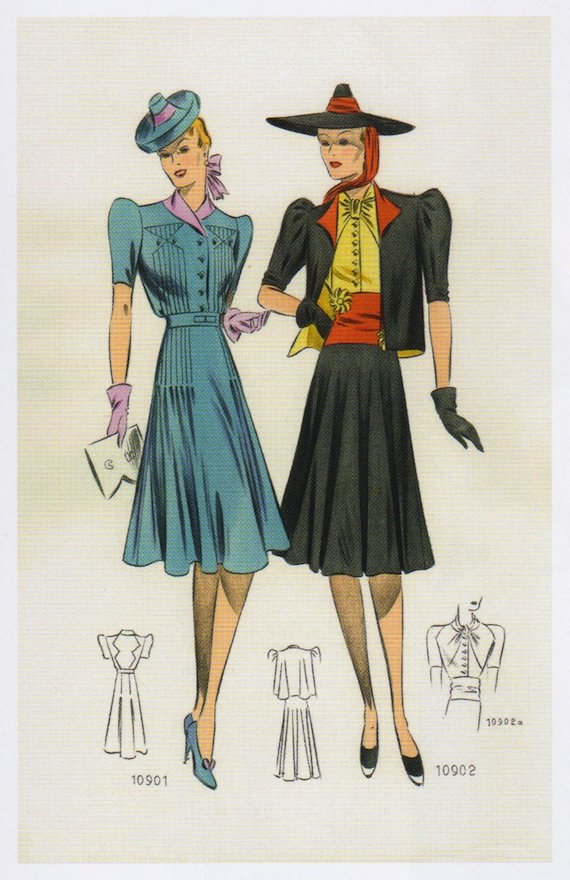
Striking colour combinations.
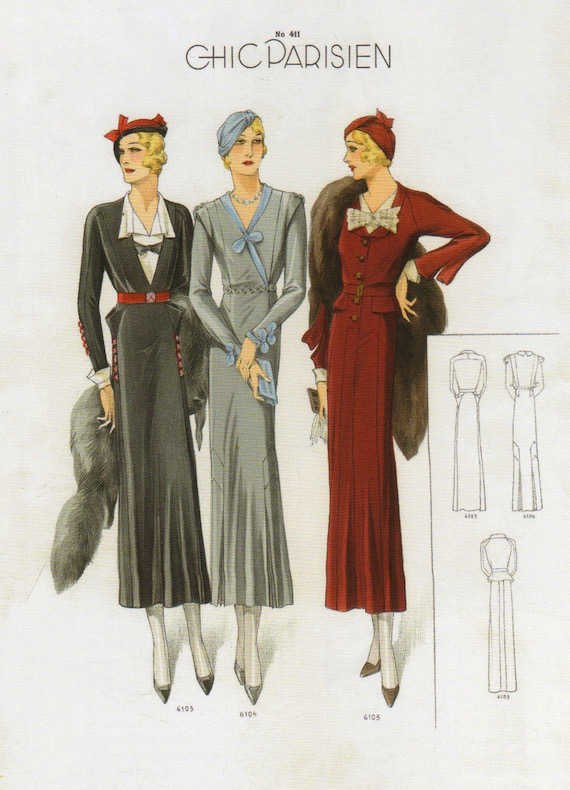
Chic colours.
Colour spanned just about every combination in 1930s fashion , with the main rule being that outfits matched with a touch of the same colour appearing on, say, a lapel, hatband, gloves and shoes, or matching belt, embroidery on the dress, a hat-feather. In this way, accessories pulled an outfit together. Cheerful bold floral prints were made for cotton summer dresses, and polka dots were popular, while stripes and nautical themes of navy, red and white looked smart and playful for beach wear.
Fun prints with motifs like landmarks including the Eiffel Tower, boats and anchors or jungle themes appeared. 1930s dresses came in shades of beige and pastel blues, pinks, peaches, mauves, violets and yellows, going into stronger teals, oranges,reds, chocolate brown, grass greens and royal blues. All shades of grey, from pearl to charcoal, looked chic, and black and white was a strong look for both daytime and evening. Some quite bold colour combinations were used, such as red, yellow and black, blue and violet, or orange white and green.
The 1930s bias cut
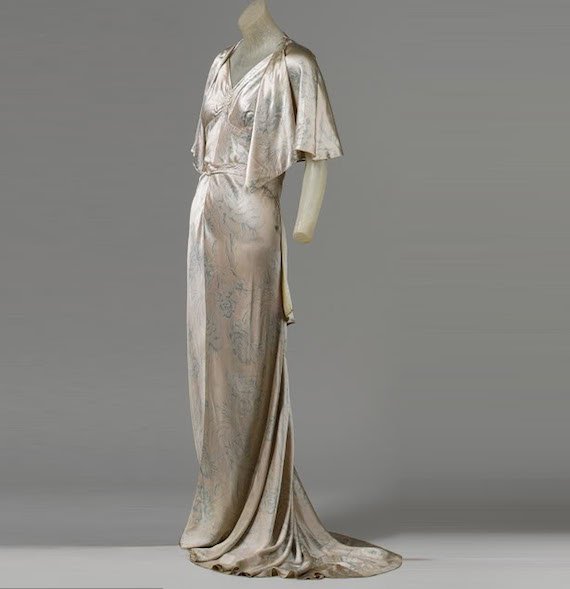
Vionnet Gown, 1930s.
The main innovation in 1930s fashion was the bias cut. Used for daywear too, its main application was in slinky flowing evening gowns and in underwear. Greatly popularised by the couturier Madeline Vionnet, bias cutting is an expensive technique, as it requires the fabric to be cut on a 45 degree angle so less pattern pieces will fit on a piece of fabric. The effect is stunning though, as the fabric then stretches and moulds itself gently to the body. Generous satin eveing gowns inspired by the drapery of Greek goddesses was the result.
1930s Jewellery
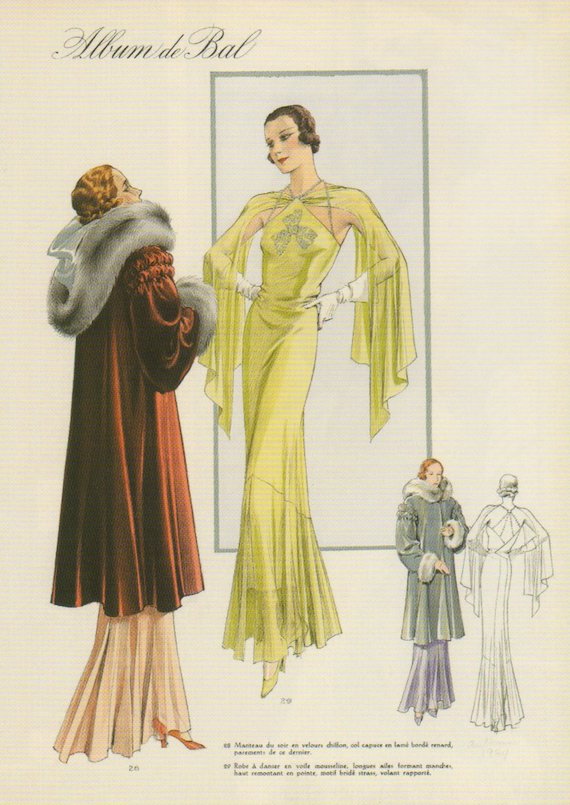
This evening gown features pearl straps at the back.
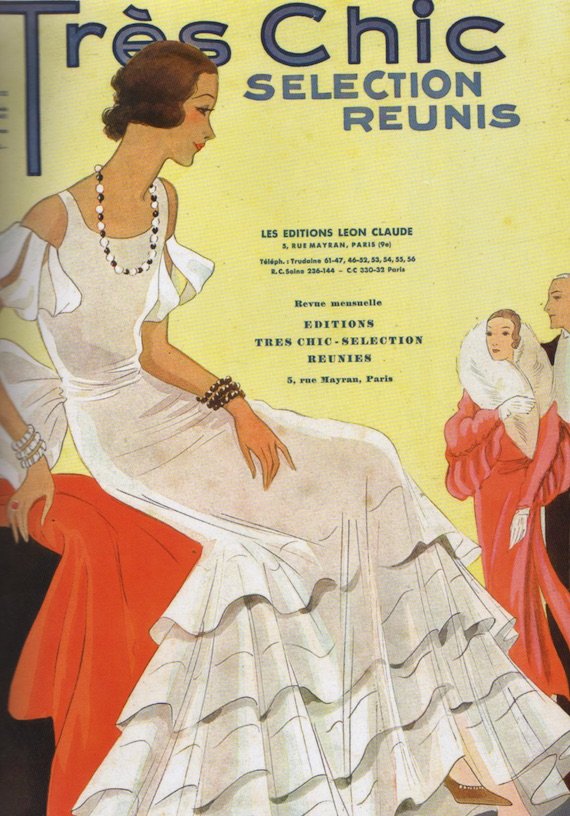
Stacks of bracelets and a bead necklace.
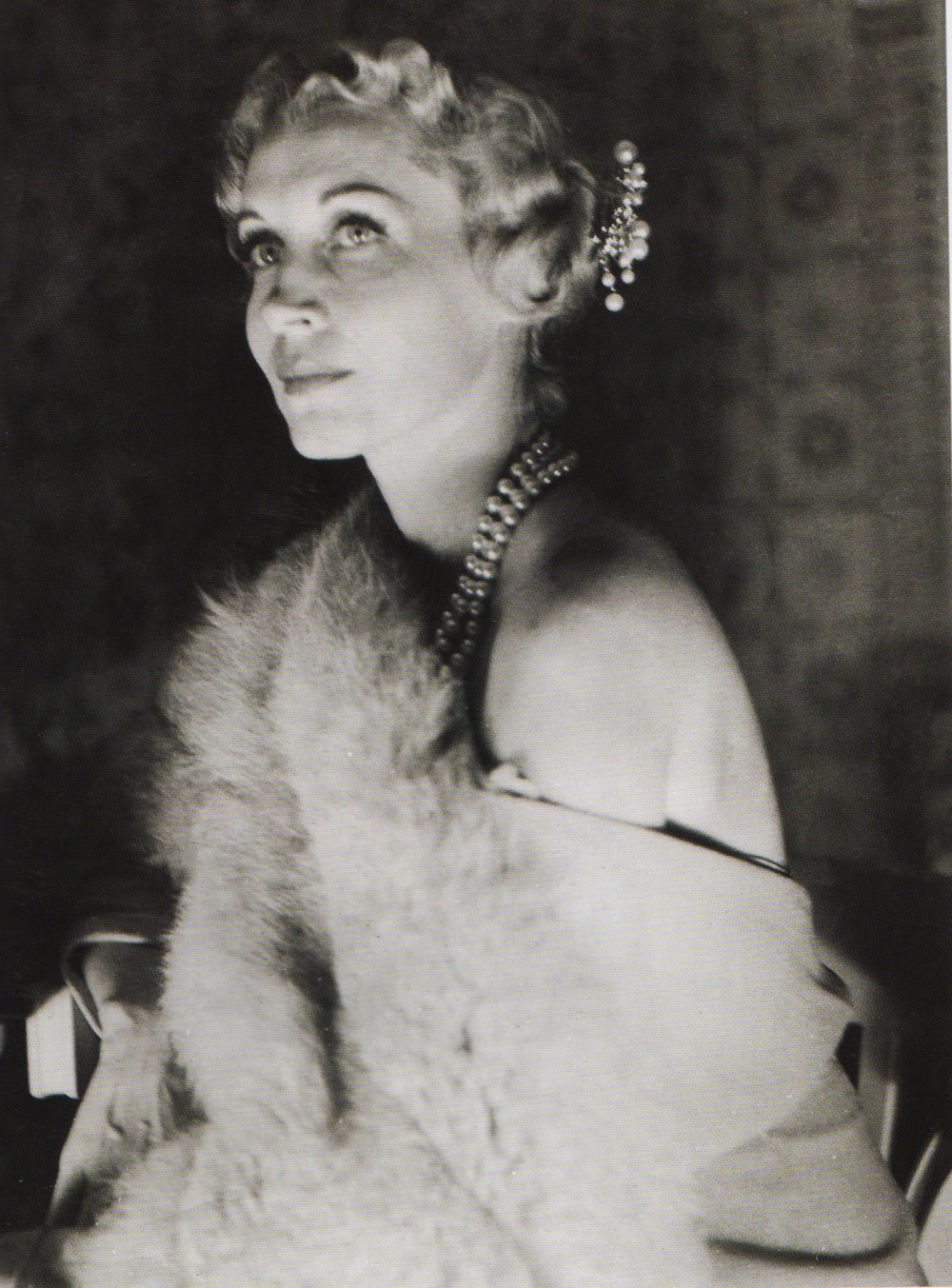
Pearls and a hair clip.
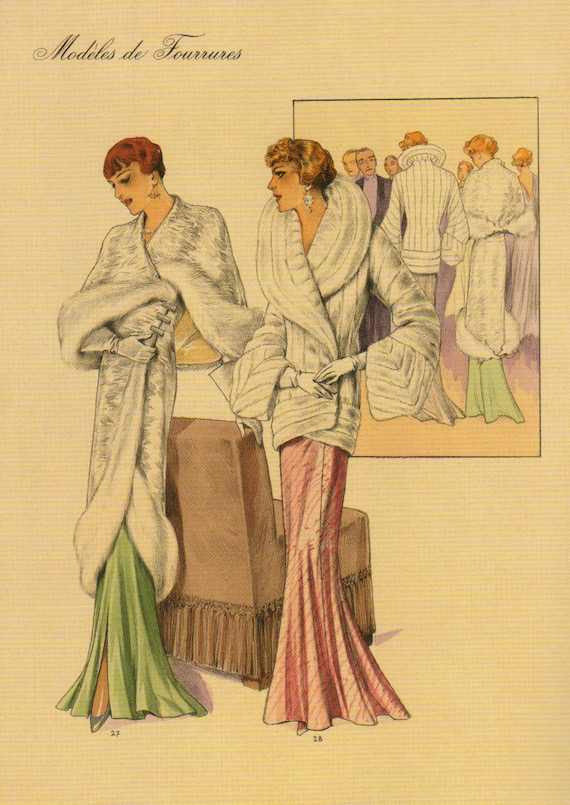
Diamond dress clips (on fur) and diamond earrings.
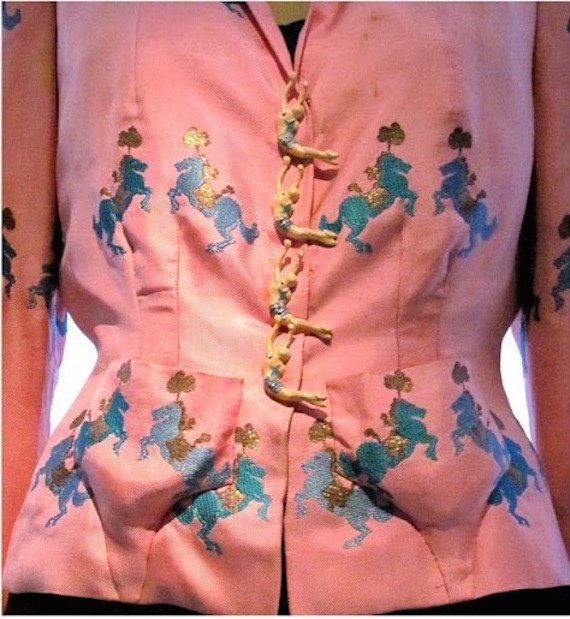
Trapeze buttons on a 1938 Schiaparelli jacket.
Buttons became a feature of outfits in 1930s fashion and were often so large or elaborate they were often the equivalent of jewellery in a look, and together with the additional decoration on clothes often ruled out the need for actual jewellery. Earrings were very rarely seen, perhaps only as a simple pearl button clip on, and equally simple short pearl necklaces or unfussy strings of beads complemented daywear. Costume jewellery in the form of big brooches pinned at the lapel or neck line, stacks of bangles, diamante dress clips, jewelled belt buckles, and unusual back jewellery designed to complement the swooping backs of evening gowns appeared. Very occasionally for lavish occasions the family heirlooms were raided, and then traditional diamond drop earrings and necklaces dazzled.
Makeup 1930s
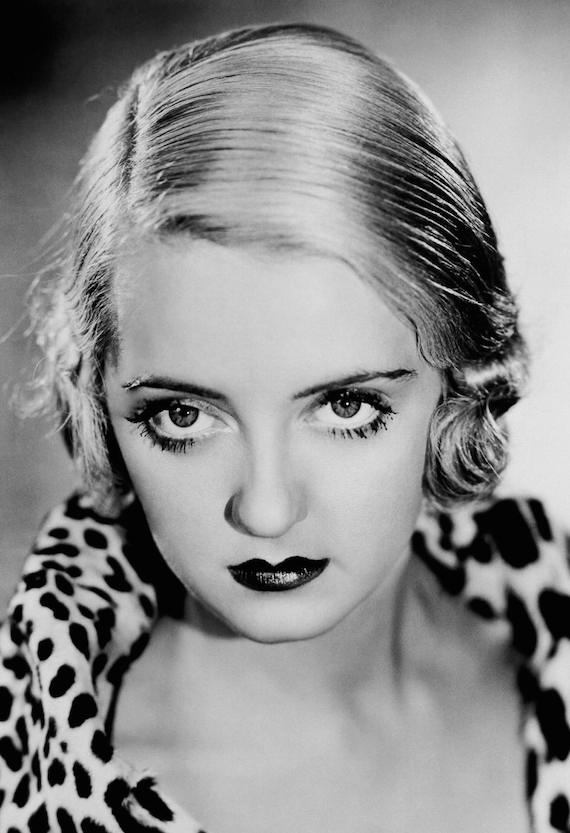
Bette Davis, 1930s.
During the 1920s, makeup had suddenly become acceptable for women and in 1930s fashion the trend continued, but colours became more varied and even more experiments were made with formulas, as more and more every day women started wearing it. The thick formulations for foundations which looked great on films didn’t work so well when passing a woman on the street, and brands like Coty advertised “Airspun” powders for a fine finish. Light pink blush was available but many women preferred to go without since a dead white, waxy complexion, not a healthy glowing one, was the prevailing trend. Later in the decade orange toned foundation took over, and dramatic, noticeable blush in raspberry or purple was worn.
Lips and Lashes in 1930s fashion
Without the silicon and technology we have today, complexions weren’t quite so flawless, and mascara was still clumpy, coming in blue or black and coating both top and bottom lashes, with dramatically curled false lashes being an alternative. Stay-on lipstick was being developed. Lips were pale pink in the early years but to contrast with the pale face grew darker and more defined later on, in colours like Oxblood, Chinese Red and Strawberry. Lipstick was applied generously with a heavy coating, and the natural lip line was extended into an exaggerated bow. The first lip gloss was created in 1932 by Max Factor, for a lighter weight alternative to lipstick.
Eyebrows
Eyebrows were plucked to a fine arch or shaved off and re-drawn altogether, extending to a dramatic wing towards the temple and sometimes highlighted in shiny Vaseline. Vaseline sometimes covered the eyelids too. The Thirties woman also experimented with eyeshadows in violet, pearl, green, brown, grey or blue to go with either her eyes or her outfit, and nails, surprisingly enough, also came in blue, green, mauve, pearl grey, gold or silver as well as conservative cream and light pink tones.
Nails
There was also a one year trend, in 1932, for black nail varnish. Towards the end of the decade coral, scarlet and darker reds became cool as women started to draw attention to their talons, and to match them with their lipstick. The nail wasn’t initially painted all over, but in the centre leaving the tips and a half moon at the cuticle. Later just the half moon was left bare. But nail varnish wasn’t widespread. In 1930s fashions It was one of the slowest of the Hollywood makeup trends to catch on, and the traditional manicure of buffing the nails with nail powder for a shiny but natural finish prevailed.
Popular perfumes for the 1930s
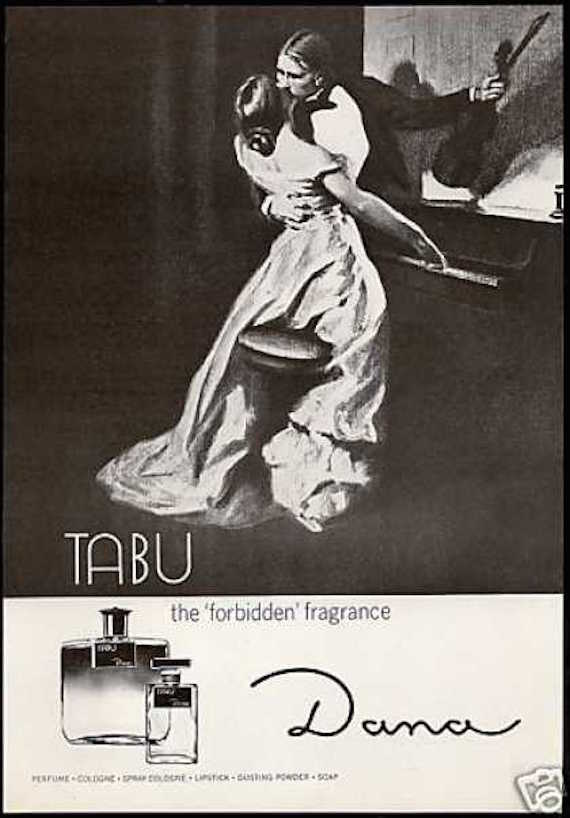
Tabu advert.
Chanel No. 5, having been released in 1921, was still the height of modernity, and other compositions echoed its chemical aldehydes. Guerlain’s Shalimar from 1925 was the opposite, heady and oriental, with the romantic story that it had been inspired by Mumtaz Mahal, the woman for whom both the Taj Mahal and the Gardens of Shalimar in Lahore, Pakistan which the perfume was named for were built. Both of these fragrances were popular in the Thirties and with some changes to their formulas, are still going strong today.
Fragrances were marketed as a touch of luxury, and though like now they were often a stretch for the average pocket they sold well. Joy, which was launched in 1929, the year of the Wall St crash and promoted as “The world’s most expensive perfume”, sold like wild fire. Other popular brands were a sexy evening perfume called Tabu by Dana launched in 1932, Blue Grass by Elizabeth Arden, and Je Reviens by House of Worth, all of which remain available today.
1930s hairstyles
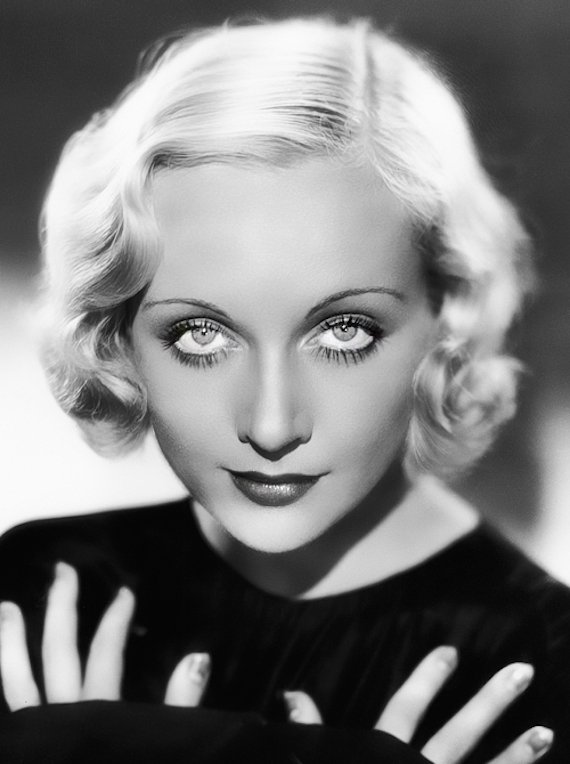
Carole Lombard.
The angular bob and daring short crops of the 1920s were being softened into a longer, permed shingle by the 1930s in line with a new mood of femininity. Of course, many woman had kept their long hair all along and many who bobbed it kept the shorter look, but those dedicated followers of fashion who had cut if off started to re-grow it. In the 1920s, dark hair, like Coco Chanel’s, was chic, but following the influence of Hollywood blonde bombshells with white blond peroxide waves were everywhere.
In-salon perms were becoming safer and slightly less damaging to the hair, as was hair colouring, and home hair dye kits started to appear with more predictable results than in the past.
1930s hats and accessories
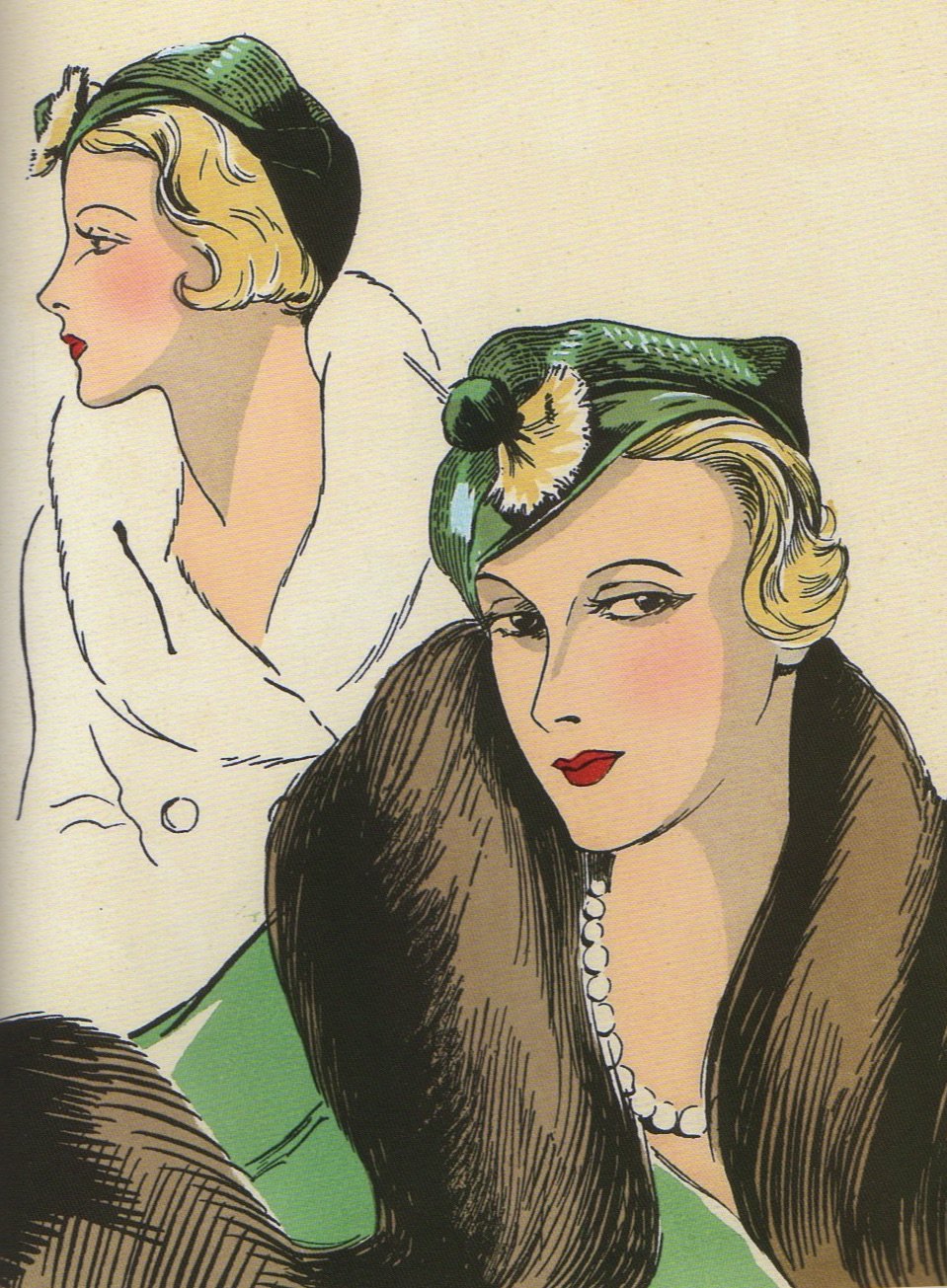
Hats.
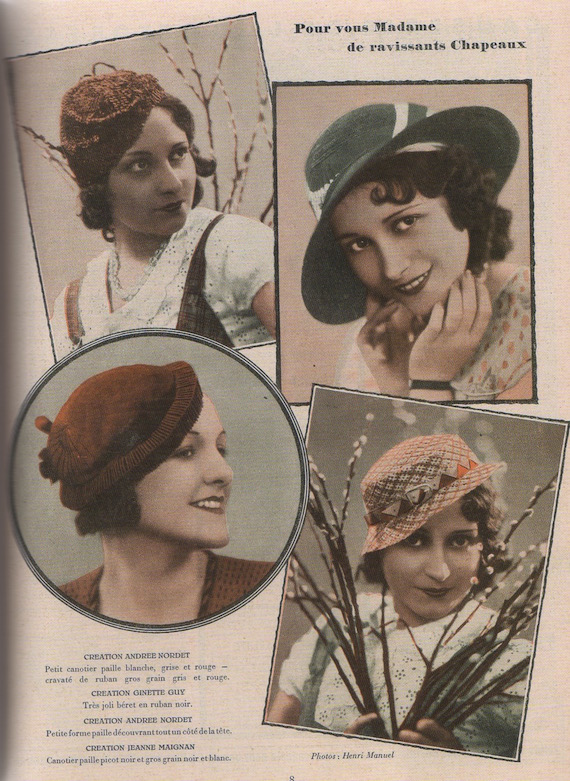
Hats, 1933.
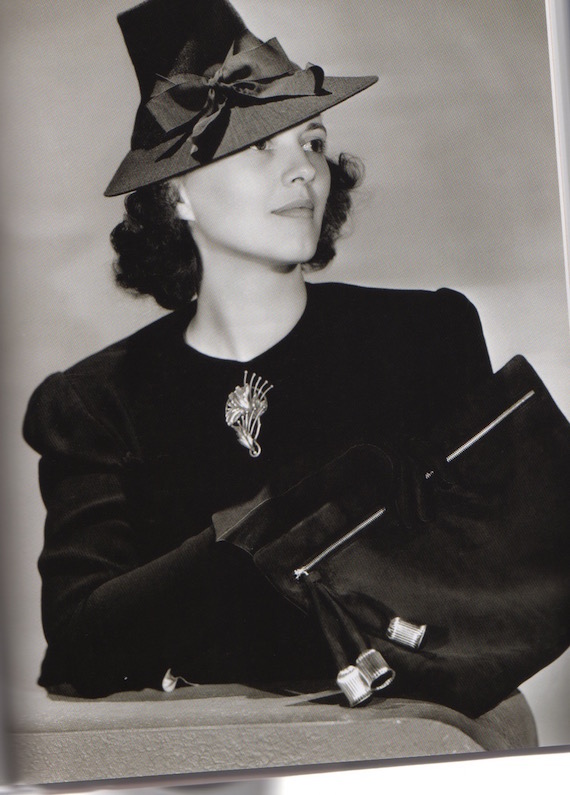
Stylish accessories, 1939.
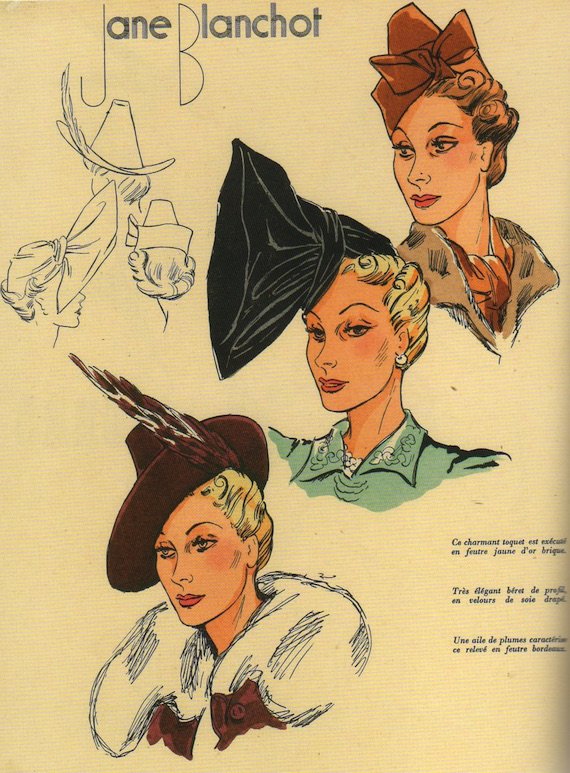
Three hat designs, 1936.
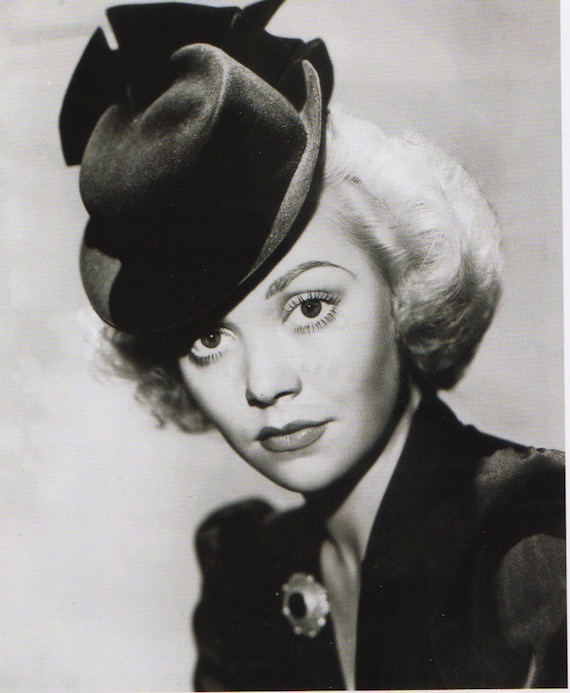
An actress showing a fashionable hat, 1939.
In the 1930s, it was still unthinkable to go out without a hat and short leather or fabric gloves were still often worn to finish off an afternoon outfit, although they were not de rigeur. They were always worn for the outdoors, even if “the outdoors” was a shopping trip, even in milder weather, and evening gowns were worn with elbow length evening gloves in black or white.
A silk scarf to compliment the outfit was worn indoors, and knitted scarves and furs worn to keep warm outdoors.
Hats
1920s cloches were still worn in 1930s fashion but the style of the hat changed direction entirely, no longer staying close to the head, covering most of the hair but giving the curls room to be shown off and not crushed. Wide brimmed straw sun hats came in, in all colours of the rainbow to match the outfit, and were worn tilted a little over one eye.
The asymmetric look was popular and smaller hats like caps and pillboxes in a variety of creative shapes, carefully chosen to exactly match the colour of outfit details were also pulled forward over the forehead towards one eye or alternatively, berets and an almost bonnet like shape sat right on the back of the head. All showed off the hairstyle. Some sported veils to be also pulled over the eye, and some had a hat band in a contrasting colour. The occasional feather was seen but decoration was minimal and the creative shape of the hat spoke for itself.
1930s handbags
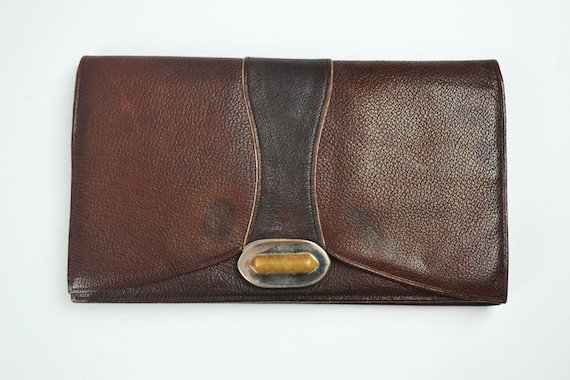
1930s clutch.
For both day and evening in 1930s fashion the small shape of the 1920s handbag stayed, and exactly the same styles were popular with little enamel and mesh purses on chains, shimmering beaded bags and home-crocheted pouches. Later on in 1930s fashion come tiny leather handbags dangled from a thin strap or chain and then slim leather clutches took over, none very roomy. Occasionally a more practical gusseted, slightly larger leather handbag is seen, held by its rigid handle.
1930s shoes
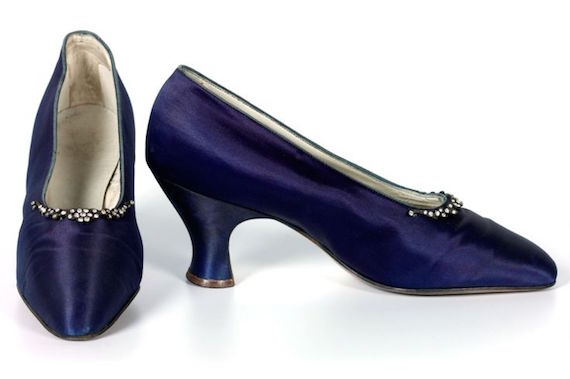
1930s satin courts.
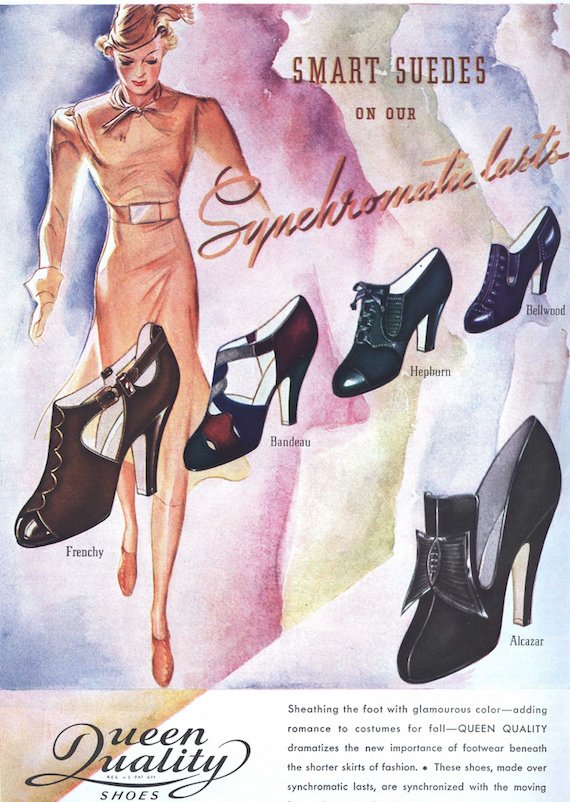
1937 shoe advert.
There was a wide variety of shoes in 1930s fashion, ranging from the flat correspondent brogues to sling back and peep toe sandals. In the early 1930s, the T-bar or Mary Jane shoes witha strap across the ankle remained popular. Most worn were kitten heeled or high heeled courts with a sturdy heel which often curved inwards to sit nearer the middle of the foot. They were cut quite high up the foot, usually in a block colour but sometimes in two, decorated with bows or laces. The toe was pointed or almond shaped.
1930s furs
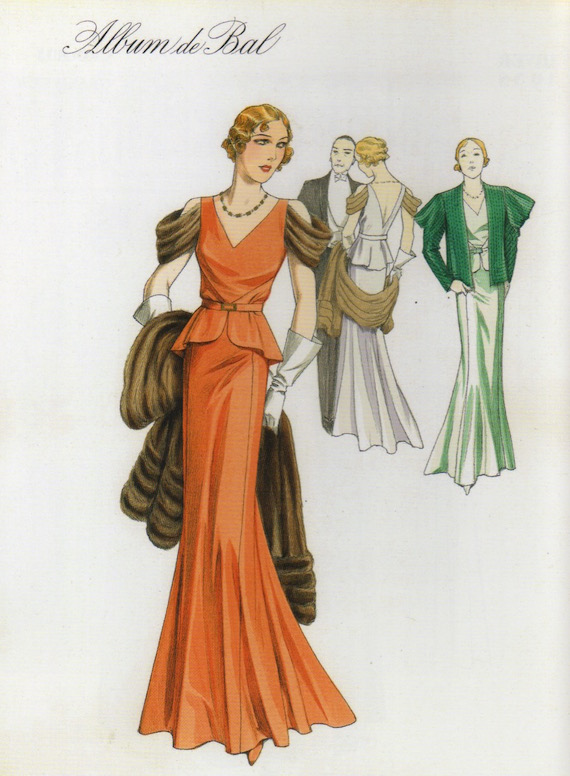
Evening gowns with fur.
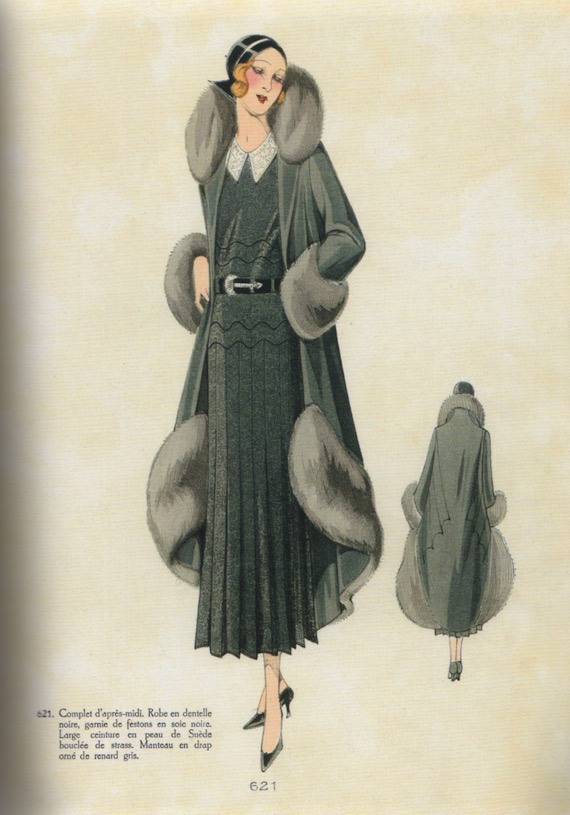
Ensemble with fur trim.
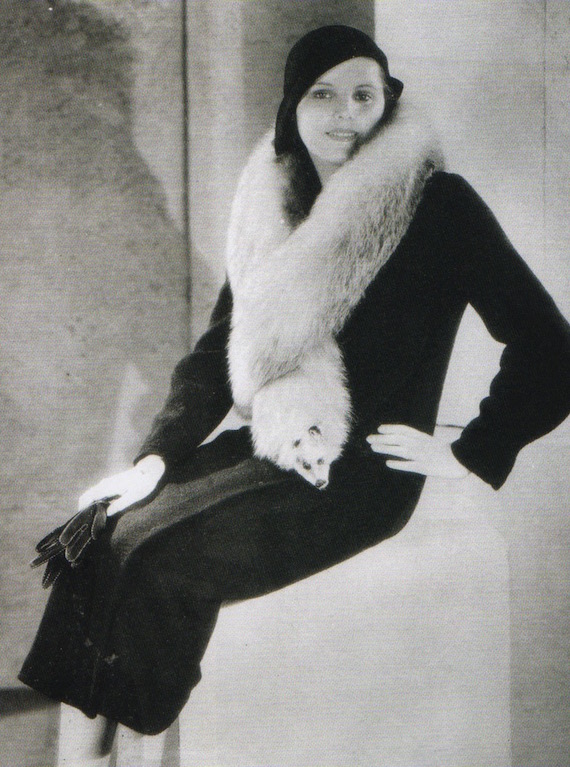
A typical white fox fur.
Fur in 1930s fashion was everywhere for day and evening, in order to look fashionable and rich and also for practical purposes – there was still no central heating. It was used for fur coats, full length, thigh length and short hip length, for coat linings, for capes, for gloves and stoles, for collars and cuffs of winter coats, for muffs, wraps and as accents and trimmings on clothes.
Fur was a luxury item and an important gift or something a woman would save for, but it came in all grades and prices: sable, mink, chinchilla, silver fox and Persian lamb were at the top of the market; marmot, muskrat and lamb at the middle and at the bottom, rabbit was dyed and sheared to resemble anything you wanted. If you couldn’t afford real fur, faux fur was available, made from cotton pile.
Fur coats
Fur coats had the fashionable, slightly exaggerated raglan shoulders of 1930s clothing but were otherwise quite slender and neat and fox stoles usually had head, tails and paws left on, fashioned so that a clip in the head meant that the head bit the tail when thrown over the shoulders. When used as a collar on a wool coat it was invariably oversized and coming high up the neck, usually complemented by matching cuffs or decorations on the arm and sometimes a matching trim at the hem, down the closure or the buttons would be covered in fur.
1930s underwear
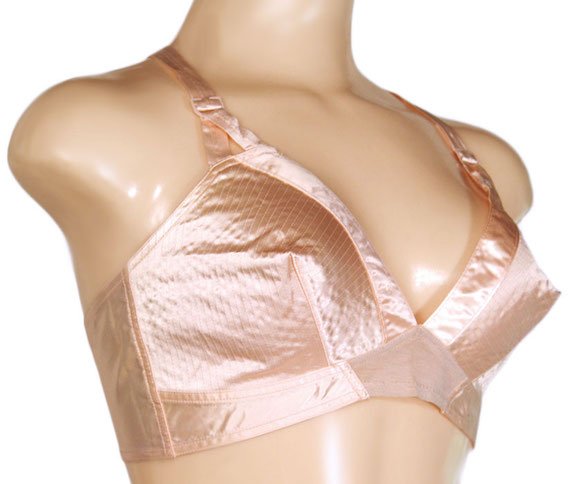
1930s bra.
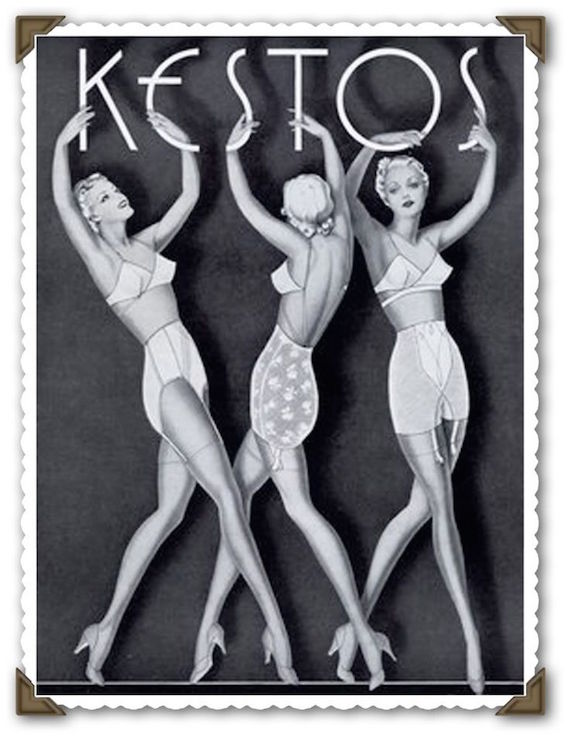
Kestos underwear, 1930s.
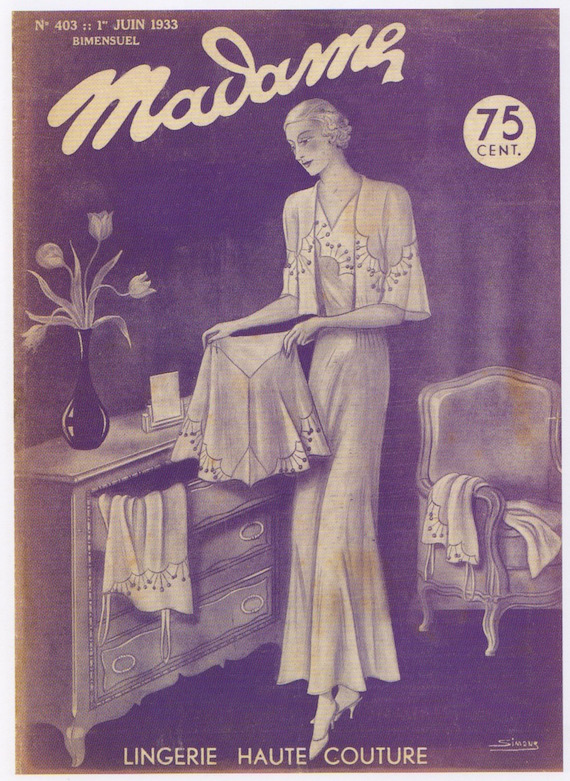
Lingerie, 1933.
30s fashion clothing required a bra and light underwear to sit right. Satin underwear in tones of ivory, peach and pinks was the most glamorous, in real silk if you could afford it or alternatively rayon if you couldn’t. Cami knickers and a vest like cami top or a combination of the two, an all in one teddy, were the fashion. For practicality however, knitted wool or cotton vest and knickers were probably more usually worn! Knitted girdles with incorporated elastic or pure rubber girdles were worn to smooth the hips and bum and in the hope of sweating off the pounds.
The structured, quite pointed bra was developed in matching silk satins. A 1930s fashion feature at the time wisely advised: “It is now common knowledge that one must have a bust.It is genrally known that the bust must be uplifted. To the elect it is now becoming apparent that the uplifted bust should also be pointed.”
1930s fashion – Wedding dresses
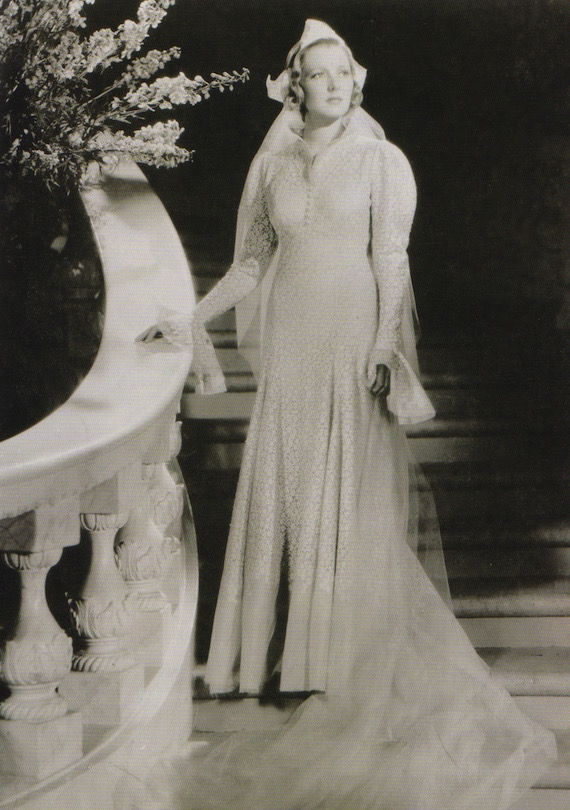
Wedding dress with lace overlay.
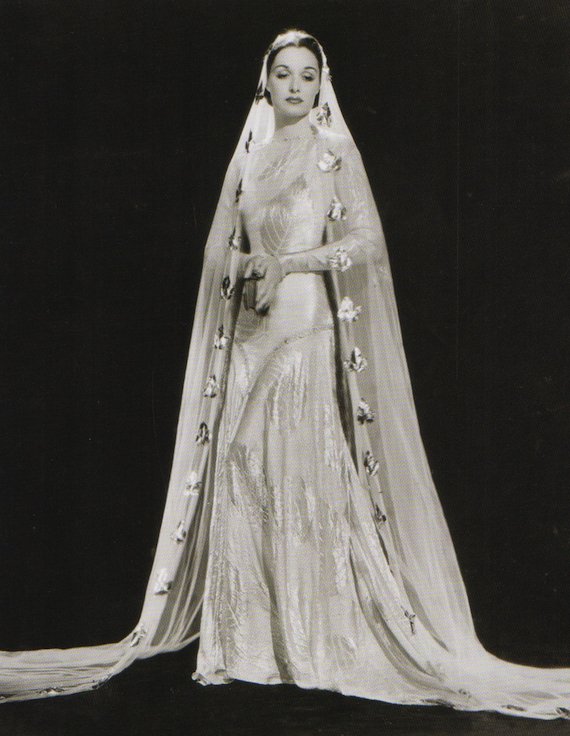
Wedding dress in bias cut silk with large self coloured leaf design in contrast texture. The veil is decorated with gold rosettes.
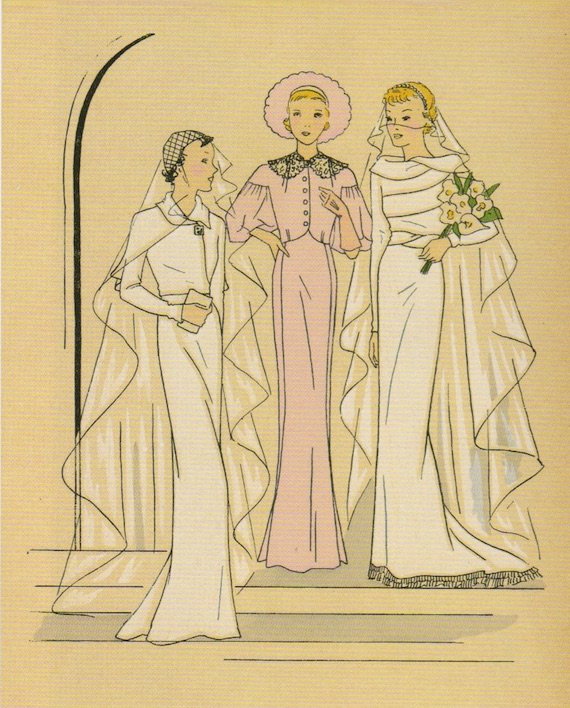
1930s wedding dresses, with maid of honour outfit in the centre.
Wedding dresses in 1930s fashion echoed the glamorous gowns of Hollywood screen sirens and gave a woman the opportunity to really be a star for a day, with slinky satin bias cut gowns moulding to the figure and hitting the ground with a long train and simple, high neckline and long, tight sleeves. Colours were predominantly white, cream and ivory, with occasional blush pink or flesh coloured, and sometimes the fabric was dull crepe self coloured with shiny motifs, or had an all over lace overlay. The veil trailed to the ground from the back of the head, and accessories were minimal, with perhaps a simple pearl necklace or a bunch of white lilies.
1930s fashion – Swimwear and beachwear
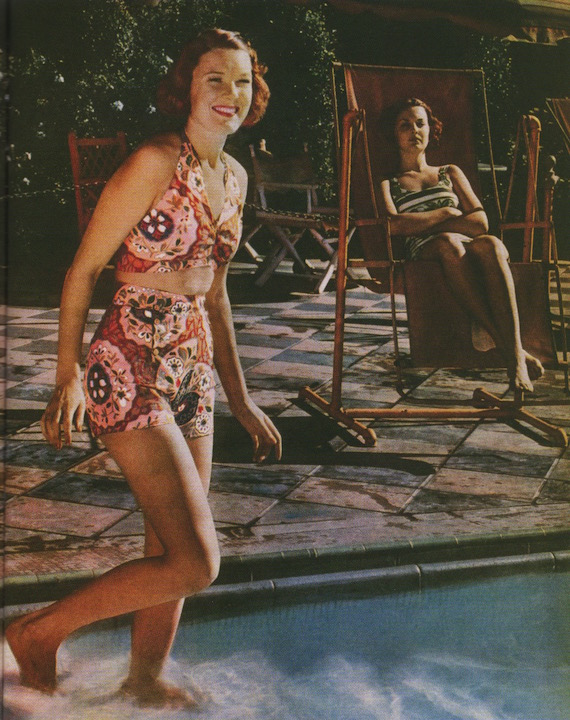
Bikini, 1937.
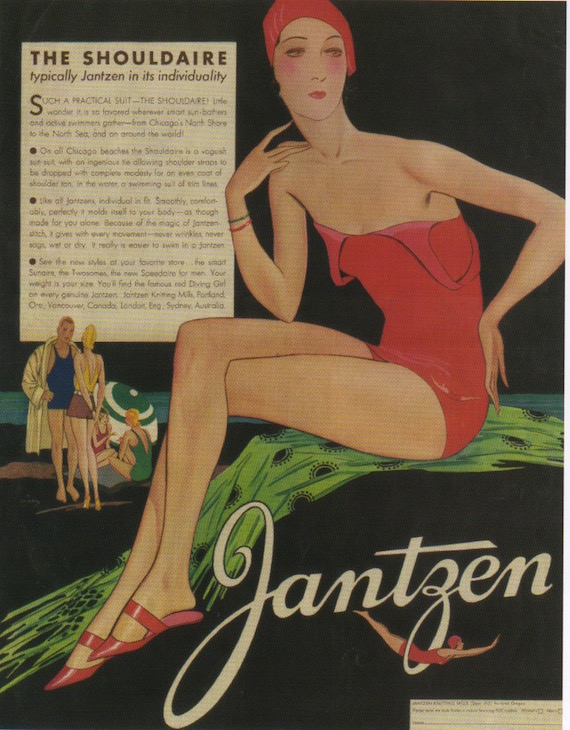
The Jantzen Shouldaire swimsuit, for tanning without lines.
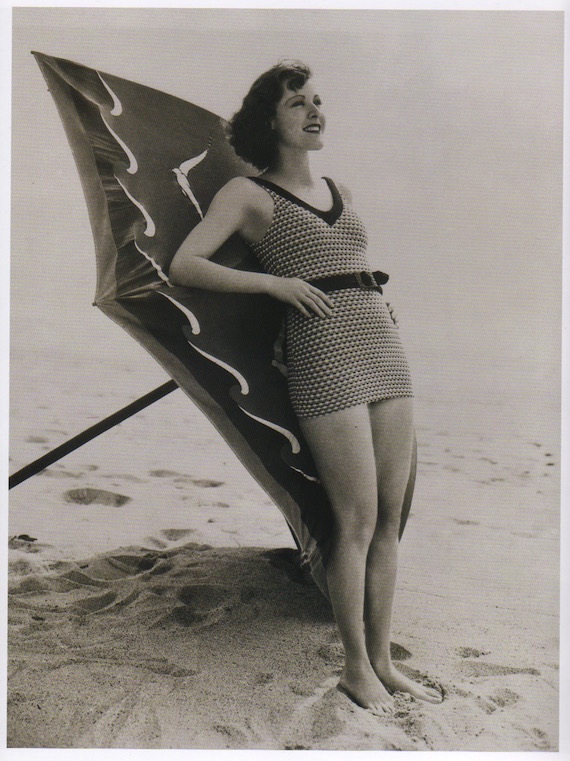
Orange, white and brown jersey swimsuit, 1933.
The story that the two-piece “bikini” was invented in 1946 and named after the test nuclear bombing of Bikini Atoll is given the lie by the existence of plenty of photos showing matching two piece combos in the 1930s, with cute patterned high waisted shorts teamed with halter tops in the same fabric for swimming. The tiny bikini-style top was also teamed with long, flowing, high waisted trousers for strolling and playing on the beach, and casual, colourful sundresses, all-in-one shorts playsuits, and mid thigh shorts were all worn for the purposes of posing and enjoying the sun.
Swimsuits in 1930s fashion
In 1930s fashion, swimsuits were as inventive as dresses, with high necks and low, scooped backs, cut outs and convertible models made for sunbathing to avoid tan lines. Swimsuits could be all in one, with legs cut straight at the thigh, bikini style, or two piece with an over dress on top of shorts. They were made from fine knitted fabric or inflexible woven cotton. Footwear was sporty plimsolls for practical purposes or high heeled sandals for posing.
I keep talking about “practical purpose” and “posing” since few women went to the beach to seriously swim: mostly they enjoyed the chance to have a change of scenery, soak up some sunshine and wear their fun outfits, which were far more revealing than those they’d wear at home. Some promenades were quite a fashion parade!
The swimsuits when wet were still baggy, saggy, and often became entirely transparent, which was a bit more revealing than many desired. In addition, women were generally thought as not really strong enough for swimming.
1930s sportswear
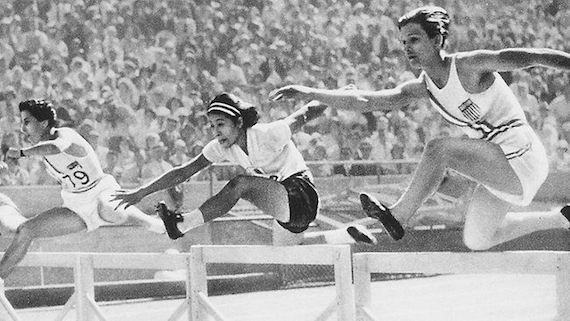
1932 Olympics – womens hurdles.
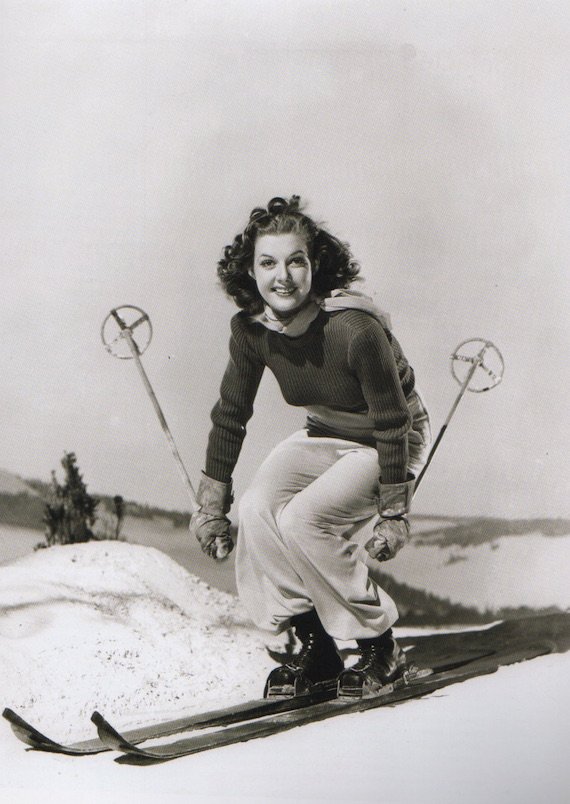
A ski outfit, 1939.
Women in 1930s fashion
Talking of swimming, the vogue for the slender but not skinny athletic body initiated health clubs where women practiced callisthenics and gymnastics and a general cult of health but warred with advice that getting breathless, never mind sweaty, was not only unladylike but surely bad for you and that women were just not built for such things.
At the 1928 summer Olympics, women competed in the 100 metre race, the 800 metre race, the relay race, high jump, and discus throw, although it was erroneously reported that the 800 metre left all the competitors so exhausted it was banned from the program until 1964.
Documentary evidence shows that far from the “11 wretched women” who started the race, five of which were reported to have not completed the race, and five of whom collapsed at the end of it, leaving only one woman upright, in fact, only nine women raced, all crossed the finish line, and only one leaned so far over it that she fell over. So much for female frailty. At the 1932 Olympics, women competed in the 100 metre sprint, 80 metre hurdles, the relay race, high jump, discus and javelin throw, and at the 1936 Olympics, it was the same. In 1940 the Olympics did not take place due to the war.
Other sporting activities in 1930s fashion
As well as field and track, sporting women competed at tennis, and horse riding, golf and skiing were major leisure pursuits for those who could afford them, while schoolgirls practiced gymnastics, hockey, fencing and archery.
Professional women’s football had been banned by the Football Association in 1921, and although teams still existed in the 1930s, it was not of widespread popularity. A lot of propaganda had gone into persuading ladies that it was a man’s game, not good for their health. Rowing was only recommended for those sturdy enough, but dancing, walking and skating were feminine, while cycling was popular, though “experts” still warned it could do terrible damage to the reproductive system.